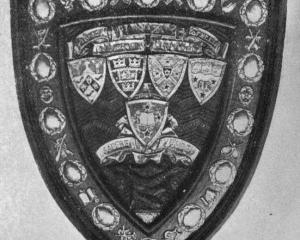
During the past week or two the grim and tragic nature of the conflict has been brought home poignantly to the people of the district by the deaths of Lieutenant Eric Standring and Private Alec Robertson, who were killed at the front. The hall was packed to the door and the Rev. Mr Standring (father of Lieutenant Standring) conducted the service. Ten wreaths, one for each of the boys from the district who have given their lives for the Empire and the cause of freedom, were ranged in front of the platform, and the reading desk was draped with the Union Jack. The members of the Middlemarch Band, Territorials, and Senior Cadets, and the members of the Oddfellows’ and Freemason Lodges marched to the hall in procession, and the flags outside the hall were flown at half mast.
Taking for his text the words "Greater love hath no man than this, that a man lay down his life for his friend", the Rev. Mr Standring delivered a most eloquent and touching address: "The cream and flower of the nation had gone forth and given their lives, and to many of them the sorrow and tragedy had come very close. Let them in their sorrow be thankful that their sons had so nobly borne their part and upheld the highest traditions of the old battle fields where the sons of Britain fought and died for liberty and freedom. They must keep the memories green of those who had gone from their mortal vision, but never from their hearts, never from their loving thoughts."
Naturalists’ outing
The fortnightly meeting of the Dunedin Naturalists’ Field Club took place on Saturday, when a large number of members and friends were present. The party went by motor conveyance over the Upper Junction road as far as the Waitati water trough. At that point they left the main road and walked through an interesting piece of bush in a valley to the left of Mihiwaka. Several varieties of coprosma were collected with their fruits still on, while the black fruits of the Schefflera and Guselinia (broadleaf) were also conspicuous. Numerous native cedars, red pines, and various forms of Panax were seen in the valley, while further on in the open a patch of Hymenophyllum Malingii was discovered in a fallen tree trunk. This curious and remarkable "filmy" fern is very rare indeed, and has not been found for some time round Dunedin. The party came out on the road above the Scott Monument, leading down to Port Chalmers, whence they returned to Dunedin by train.
Message by pigeon
The value of homing pigeons was demonstrated on Thursday, as the following will show. The ketch Lily, owned by Pasco Bros., left Bluff for Gulches Head (on Coal Island, Preservation Inlet) over five weeks ago, and no word having been received as to her safe arrival relatives and friends began to feel anxious. Their fears were relieved, however, by the arrival of two homing pigeons carrying messages to the effect that the boat was safe. Another slip contained a list of provisions required. The skipper of the ketch, Captain Hanning, reported that all was well. The messages via pigeon post were sent to Messrs Purdie and Fraser, to whom the birds belonged. The vessel, which has been detained by bad weather, arrived in Riverton on Thursday. — ODT, 11.9.1917.
• COPIES OF PICTURE AVAILABLE FROM ODT FRONT OFFICE, LOWER STUART ST, OR WWW.OTAGOIMAGES.CO.NZ












